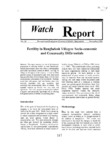| dc.contributor.author | Hadi, Abdullahel | |
| dc.date.accessioned | 2019-11-13T08:40:32Z | |
| dc.date.available | 2019-11-13T08:40:32Z | |
| dc.date.issued | 1998-11 | |
| dc.identifier.citation | Hadi, A. (1998, November). Fertility in Bangladesh villages: socio-economic and community differentials. Research Reports (1998): Health Studies, Vol - XXV, 117–119. | en_US |
| dc.identifier.uri | http://hdl.handle.net/10361/12946 | |
| dc.description.abstract | Abstract: This report assesses the role of development
programme in reducing fertility in rural Bangladesh.
Data for this research came from Watch, a demographic
and health surveillance system of BRAC covering 70
villages in 10 regions of the country. A total of 9,862
married women of reproductive ages were interviewed
that provided their fertility history along with the basic
socioeconomic information of the households. Findings
reveal that both general and total fertility rates were
inverselv associated with age, education, land
ownership and socioeconomic status of women. The
regional variation in fertility was very high and
significant. The credit programme participation played
a negative and statistically significant role in reducing
both general and total fertility in rural Bangladesh. | en_US |
| dc.language.iso | en | en_US |
| dc.publisher | BRAC Research and Evaluation Division (RED) | en_US |
| dc.subject | Fertility | en_US |
| dc.subject | Community differentials | en_US |
| dc.subject | BRAC | en_US |
| dc.subject | Rural Bangladesh | en_US |
| dc.subject | Rural community | en_US |
| dc.subject.lcsh | Fertility, Human | |
| dc.subject.lcsh | Social classes | |
| dc.subject.lcsh | Rural health -- Bangladesh. | |
| dc.title | Fertility in Bangladesh villages: socio-economic and community differentials | en_US |
| dc.type | Research report | en_US |

